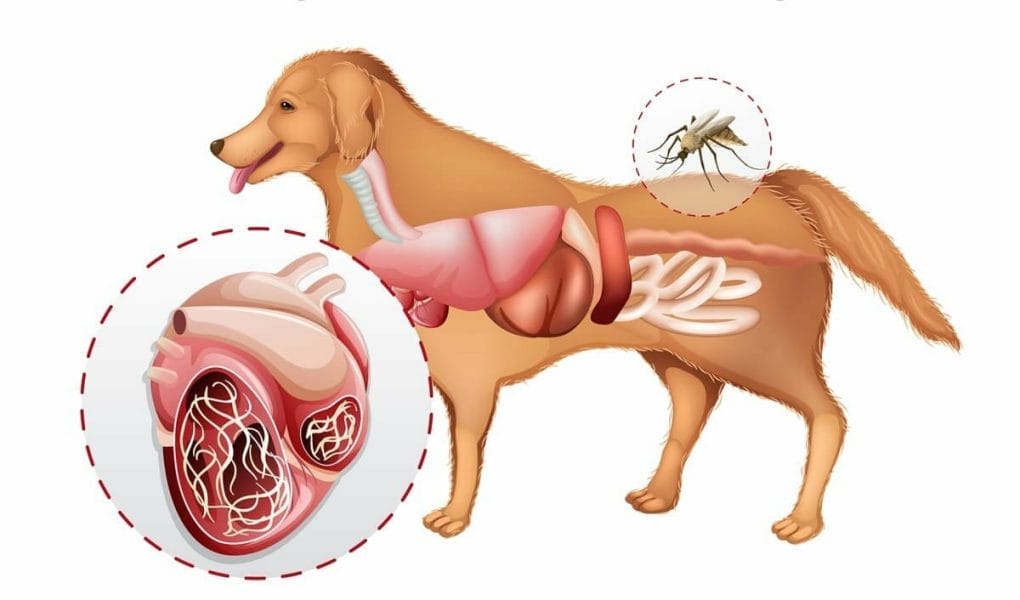If you’re a dog owner, it’s essential to be aware of the potential dangers that worms can pose to your furry friend. Worm infestations, if left untreated, can lead to serious health issues and even be fatal for your canine companion. In this article, we will explore the lifespan of worms in dogs and discuss the importance of regular deworming to ensure your dog’s well-being and longevity. So, let’s take a closer look at how long a dog can have worms before it reaches a critical point, and why prompt intervention is crucial for their overall health.
Understanding common types of worms in dogs
Identifying roundworms in dogs
Roundworms are one of the most common types of worms that can infect dogs. These worms are usually white or light brown in color and can resemble strands of spaghetti. They live in the dog’s intestines and can grow up to several inches long. If you suspect that your dog has roundworms, you may notice them in your dog’s vomit or stool. It’s important to consult with your veterinarian for proper diagnosis and treatment.
Effects of hookworms
Hookworms are another type of intestinal parasite that can infest dogs. These worms have hooked mouthparts that attach to the lining of the dog’s intestines, causing damage and resulting in blood loss. This can lead to anemia in dogs, which can cause symptoms such as fatigue, pale gums, and weakness. Hookworm infestations can be particularly dangerous for puppies, as they are more susceptible to the effects of blood loss.
Dangers of whipworms
Whipworms are small, thread-like worms that live in the large intestine of dogs. They get their name from their whip-like shape. Whipworm infestations can cause chronic diarrhea, weight loss, and even bloody stool in dogs. These worms are quite resilient and can survive in the environment for long periods of time. Prevention and regular deworming are crucial in keeping your dog safe from whipworm infections.
Threat of tapeworms
Tapeworms are long, flat worms that can infect dogs. They are made up of segments, and each segment can contain numerous eggs. These segments may appear as small, white rice-like grains in your dog’s feces or around their anal area. Tapeworms can be transmitted to dogs through the ingestion of fleas or small mammals. It’s important to treat both the tapeworm infection and any underlying flea infestation to prevent reinfestation.
Heartworm disease in dogs
Heartworm disease is a serious and potentially life-threatening condition that can affect dogs. It is caused by the bite of infected mosquitoes and the subsequent migration of heartworm larvae to the dog’s heart and lungs, where they grow into adult worms. The presence of adult heartworms can cause blockages in the heart and blood vessels, leading to heart and lung problems. Heartworm disease can be prevented through regular administration of preventative medications recommended by your veterinarian.
Symptoms of worms in dogs
Appetite changes
One of the first signs that your dog may have worms is a change in their appetite. They may suddenly have an increased or decreased appetite, or they may start eating grass or dirt. This change in behavior can be a result of the worms interfering with your dog’s digestion.
Weight loss
Unexplained weight loss can also be a symptom of worms in dogs. Worms feed off the nutrients that your dog ingests, leading to inadequate nourishment for your pet. If you notice that your dog is losing weight despite a normal or increased appetite, it’s important to consider the possibility of a worm infestation.
Changes in stool appearance
Another indicator of worms in dogs is a change in the appearance of their stool. You may notice that the stool becomes loose, has a mucus-like consistency, or contains blood. Some worms, like the hookworm, can cause bloody diarrhea in dogs. If you observe any abnormality in your dog’s stool, it’s essential to consult your veterinarian for further evaluation.
Visible worms or eggs in the dog’s fur or in their feces
In some cases, you may actually see worms in your dog’s fur or in their feces. Roundworms and tapeworms, in particular, are visible to the naked eye. They may appear as long, spaghetti-like strands or small, white rice-like grains. If you observe any worms or eggs, it’s important to collect a sample and bring it to your veterinarian for proper identification.
Decreased activity or lethargy
Infestations of worms can cause dogs to become lethargic or less active than usual. This decrease in energy levels can be attributed to the effects of the worms on your dog’s overall health and well-being. If you notice a sudden lack of interest in activities or excessive fatigue, it’s important to consider the possibility of a worm infestation and seek veterinary attention.

How dogs get infested with worms
Flea infestation leading to tapeworms
One common way that dogs become infested with tapeworms is through the ingestion of fleas. Fleas can carry tapeworm eggs, and when a dog ingests a flea while grooming or biting at their skin, the tapeworm eggs are released into the dog’s body. Once inside the dog, the tapeworm eggs develop into adult tapeworms, leading to an infestation.
Ingestion of infected soil or feces
Dogs can contract various types of worms by ingesting soil or feces that have been contaminated with worm eggs or larvae. This can happen when dogs sniff or lick the ground, consume contaminated water, or eat feces from infected animals. It’s important to keep your dog away from areas where other dogs defecate and to pick up and properly dispose of your dog’s feces to minimize the risk of infestation.
Mother-to-puppy transmission
Puppies can be infected with worms while still in their mother’s womb or through nursing. Some types of worms can be transmitted from the mother to her puppies through the placenta or through the milk. It’s essential to ensure that pregnant dogs are regularly dewormed and that nursing puppies are dewormed at appropriate intervals to prevent infestations.
Exposure from other infected animals
Dogs can also become infested with worms by coming into contact with other infected animals. This can occur through interactions at parks, kennels, or shelters. It’s crucial to be cautious when introducing your dog to new animals and to regularly deworm your dog to prevent any potential infestation from spreading.
Duration of worm infestation
Length of worm lifecycle inside a dog’s body
The duration of a worm infestation in a dog can vary depending on the specific type of worm. Different worms have different lifecycles, which can range from a few weeks to several months. For example, the lifecycle of a roundworm typically takes about three weeks, whereas the lifecycle of a tapeworm can take up to three months. The duration of infestation is influenced by factors such as the worm species and the dog’s overall health.
Impact of the infestation’s severity
The severity of the worm infestation can also affect the duration. Dogs with mild infestations may recover more quickly with appropriate treatment, while dogs with severe infestations may require a longer treatment period. It’s important to consult with your veterinarian to determine the severity of the infestation and to develop an appropriate treatment plan.
Effects of the dog’s immune response
The dog’s immune response plays a role in how long a dog can have worms before it dies. A strong immune system can help fight off the infestation and prevent it from progressing to a life-threatening stage. However, a weakened immune system, such as in young puppies or older dogs, may be less effective in combating the worms, leading to a longer duration of infestation.
Influence of concurrent health issues
The presence of concurrent health issues can also impact the duration of a worm infestation. Dogs with underlying health conditions may have a compromised immune system, making them more susceptible to the effects of the worms. Additionally, certain health issues can affect the dog’s ability to tolerate and respond to treatment, potentially prolonging the duration of the infestation.

Gastrointestinal issues
Worm infestations in dogs can cause a variety of gastrointestinal problems. The worms can irritate and damage the lining of the dog’s intestines, leading to symptoms such as diarrhea, vomiting, and abdominal pain. Prolonged infestations can result in chronic gastrointestinal issues, affecting the dog’s overall well-being and quality of life.
Heart and lung problems
Heartworm disease, in particular, can have serious health implications for dogs. The adult heartworms can cause blockages in the heart and blood vessels, leading to heart and lung problems. This can result in symptoms such as coughing, difficulty breathing, and exercise intolerance. If left untreated, heartworm disease can be fatal.
Anemia
Certain worms, such as hookworms, can cause anemia in dogs due to blood loss from their attachment to the intestinal lining. Anemia can lead to symptoms such as fatigue, pale gums, and weakness. Severe cases of anemia can be life-threatening if not addressed promptly.
Nutritional deficiencies
Worms feed off the nutrients that the dog ingests, which can lead to nutritional deficiencies. This can cause weight loss, poor coat quality, and a weakened immune system. Nutritional deficiencies can have long-term implications for a dog’s overall health and can delay their recovery from the infestation.
Physical discomfort and pain
Worm infestations can cause physical discomfort and pain in dogs. The worms can cause irritation and inflammation in the dog’s intestines, leading to discomfort and abdominal pain. Additionally, certain types of worms, such as tapeworms, can cause itching and irritation around the dog’s anus, resulting in discomfort and a tendency to scoot or drag their rear end on the ground.
How worms can cause death in dogs
Potential for fatal intestinal blockages
In some cases, a severe infestation of worms can result in a blockage of the dog’s intestines. This can occur when there is a large number of worms or when the worms clump together, forming a mass that obstructs the passage of food and waste through the digestive system. Intestinal blockages can be life-threatening if not promptly addressed through surgical intervention.
Chronic health deterioration
Prolonged infestations of worms can lead to chronic health deterioration in dogs. The ongoing damage caused by the worms to the dog’s gastrointestinal system and the resulting nutritional deficiencies can weaken the dog’s overall health and make them more susceptible to other illnesses and conditions. If left untreated, this chronic deterioration can eventually lead to the dog’s death.
Severe infestations leading to organ failure
In severe cases, infestations of worms can cause damage to the dog’s organs. This can occur when the worms migrate to other parts of the body or when the infestation becomes overwhelming. Organ failure can be life-threatening and may require intensive veterinary intervention to treat or manage the condition.
Complications from heartworm disease
Heartworm disease can be particularly dangerous and potentially fatal for dogs. If left untreated, the presence of adult heartworms can cause irreversible damage to the dog’s heart and lungs. This can lead to congestive heart failure, respiratory distress, and ultimately, the death of the affected dog. It is crucial to prevent heartworm disease through regular administration of preventive medications and to seek immediate treatment if the disease is detected.

Diagnosis and Treatment of worms in dogs
Veterinary diagnosis methods
Diagnosing a worm infestation in dogs typically involves a combination of physical examination, fecal tests, and sometimes blood tests. During the physical examination, the veterinarian may observe any visible signs of worms and ask questions about the dog’s symptoms and medical history. Fecal tests are used to identify the presence of worm eggs or larvae in the dog’s stool. Blood tests, such as serology or antigen tests, can be used to diagnose heartworm disease.
Options for worming treatments
The treatment for worms in dogs will depend on the specific type of worm and the severity of the infestation. Deworming medications, also known as anthelmintics, are commonly prescribed to eliminate the worms from the dog’s system. These medications can be administered orally or through injections, depending on the specific medication and the veterinarian’s recommendation. In some cases, multiple treatments may be necessary to completely eliminate the worms.
Importance of follow-up care
Follow-up care is crucial in ensuring the successful treatment of worms in dogs. This may involve additional fecal tests to confirm the elimination of the worms, as well as monitoring the dog’s overall health and well-being. It’s important to follow the veterinarian’s instructions regarding medication administration, feeding, and any other recommended care guidelines to maximize the chances of a full recovery.
Challenges with treating heartworm
Treating heartworm disease can be particularly challenging due to the potential complications associated with the presence of adult heartworms. The treatment typically involves a series of injections to kill the adult worms, followed by a period of rest and recovery. It’s important to closely follow the veterinarian’s instructions during the treatment process, as any strenuous activity can increase the risk of complications.
Preventing worm infestations in dogs
Tips for outdoor play and excursions
To reduce the risk of worm infestations, it’s important to be mindful of your dog’s outdoor activities. Avoid areas where other dogs defecate, as they may be contaminated with worm eggs or larvae. Additionally, prevent your dog from consuming soil, grass, or other potential sources of contamination. Regularly inspect and clean your dog’s paws and fur after outdoor play to remove any potential sources of worms.
Regular flea prevention
Since fleas can transmit tapeworms to dogs, it’s crucial to implement regular flea prevention measures. Consult with your veterinarian to determine the most appropriate flea prevention method for your dog. This may involve topical treatments, oral medications, or the use of flea collars. Regularly inspect your dog for fleas and promptly address any signs of infestation to prevent tapeworm transmission.
Safe handling of dog feces
Proper handling and disposal of dog feces are essential in preventing the spread of worms. Always clean up after your dog and dispose of the feces in a sealed bag in the appropriate waste bin. Avoid touching the feces directly and wash your hands thoroughly afterward. This will help prevent the contamination of the environment and reduce the risk of transmission to other dogs and humans.
Keeping your dog’s environment clean
Maintaining a clean and hygienic environment for your dog can help prevent worm infestations. Regularly clean and sanitize your dog’s bedding, toys, and food and water bowls. Vacuum and mop the floors to remove any potential sources of worms, especially if you have multiple dogs or if your dog frequently interacts with other animals. Additionally, practice good hygiene when handling your dog, ensuring that you wash your hands regularly and keep your dog’s living areas clean and well-maintained.

Implications for dog owners
Managing a household with a dog infected with worms
Dealing with a dog infected with worms can be challenging, but with proper management and veterinary care, it is possible to address the infestation and protect the health of your dog. Follow the treatment plan recommended by your veterinarian, including regular deworming, medication administration, and follow-up care. Practice good hygiene to prevent the spread of worms within your household, and be vigilant in monitoring your dog’s health for any signs of recurrence or complications.
Importance of regular vet checks
Regular veterinary check-ups are an important part of maintaining your dog’s overall health and well-being. Your veterinarian can perform routine examinations, fecal tests, and other diagnostic procedures to detect and address any potential worm infestations. They can also provide guidance on preventive measures and appropriate treatments to minimize the risk of infestations and promote the long-term health of your dog.
Potential for human infection
It’s important to be aware that certain types of worms can be transmitted from dogs to humans. This is especially true for children, elderly individuals, and those with compromised immune systems. Practicing good hygiene, such as washing hands thoroughly after handling your dog and avoiding close contact with their feces, can reduce the risk of human infection. If you have concerns about potential transmission to humans, consult with your veterinarian or healthcare provider for further guidance.
Conclusion: Prognosis for dogs with worms
Factors influencing survival rates
The prognosis for dogs with worms can vary depending on several factors. Early detection and prompt treatment play a crucial role in improving the chances of a successful recovery. The type and severity of the infestation, the overall health of the dog, and the presence of any concurrent health issues can also influence the prognosis. It’s important to consult with your veterinarian for an accurate assessment of your dog’s condition and to develop an appropriate treatment plan.
Importance of early detection
Early detection of worm infestations is key in preventing complications and improving the prognosis for dogs. Regular veterinary check-ups, fecal tests, and vigilant monitoring of your dog’s health can help identify any signs of infestation early on. By addressing the infestation promptly, you can minimize the risk of complications and enhance your dog’s chances of a full recovery.
Potential lifespan after successful treatment
With appropriate diagnosis, treatment, and follow-up care, dogs with worm infestations can go on to live long and healthy lives. The success of the treatment will depend on factors such as the type of worm, the severity of the infestation, and the dog’s overall health. By adhering to the recommended treatment plan and practicing preventive measures, you can help ensure the long-term well-being of your dog and minimize the risk of future infestations.
In conclusion, it is crucial for dog owners to be knowledgeable about the common types of worms that can infest dogs, the symptoms to look out for, and the potential health complications that can arise. By understanding the ways in which dogs can become infested with worms, owners can take appropriate preventative measures to protect their pets. Early detection, accurate diagnosis, and timely treatment are essential in managing and preventing the detrimental effects of worm infestations. Regular veterinary care, good hygiene practices, and a clean environment can contribute to the overall health and well-being of dogs, ensuring a happy and worm-free life.






Leave a Reply
You must be logged in to post a comment.